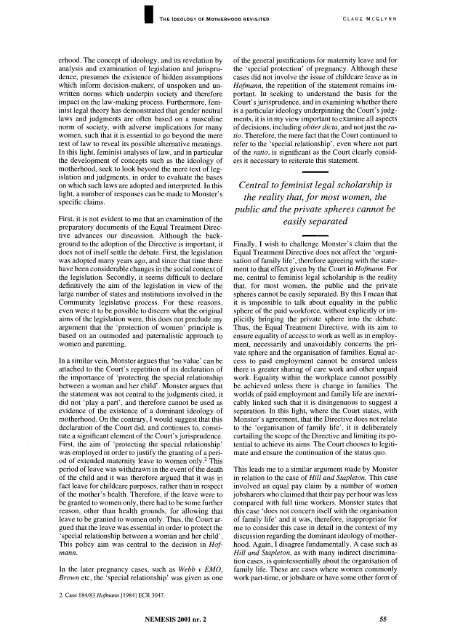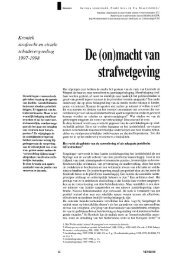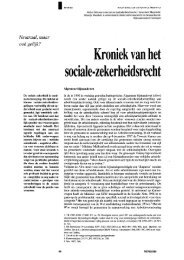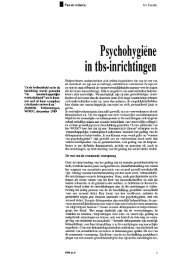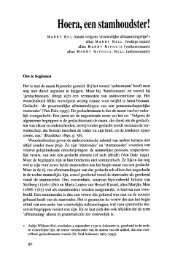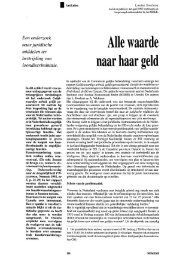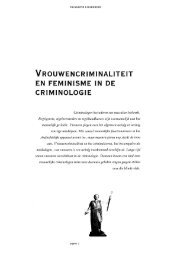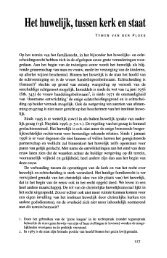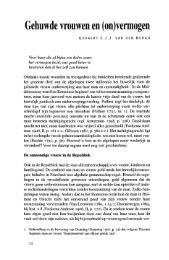maart/april 2001 de moederschapsideologie van het ... - Nemesis
maart/april 2001 de moederschapsideologie van het ... - Nemesis
maart/april 2001 de moederschapsideologie van het ... - Nemesis
Create successful ePaper yourself
Turn your PDF publications into a flip-book with our unique Google optimized e-Paper software.
erhood. The concept of i<strong>de</strong>ology, and its revelation by<br />
analysis and examination of legislation and jurispru<strong>de</strong>nce,<br />
presumes the existence of hid<strong>de</strong>n assumptions<br />
which inform <strong>de</strong>cision-makers; of unspoken and unwritten<br />
norms which un<strong>de</strong>rpin society and therefore<br />
impact on the law-making process. Furthermore, feminist<br />
legal theory has <strong>de</strong>monstrated that gen<strong>de</strong>r neutral<br />
laws and judgments are often based on a masculine<br />
norm of society, with adverse implications for many<br />
women, such that it is essential to go beyond the mere<br />
text of law to reveal its possible alternative meanings.<br />
In this light, feminist analyses of law, and in particular<br />
the <strong>de</strong>velopment of concepts such as the i<strong>de</strong>ology of<br />
motherhood, seek to look beyond the mere text of legislation<br />
and judgments, in or<strong>de</strong>r to evaluate the bases<br />
on which such laws are adopted and interpreted. In this<br />
light, a number of responses can be ma<strong>de</strong> to Monster's<br />
specific claims.<br />
First, it is not evi<strong>de</strong>nt to me that an examination of the<br />
preparatory documents of the Equal Treatment Directive<br />
ad<strong>van</strong>ces our discussion. Although the background<br />
to the adoption of the Directive is important, it<br />
does not of itself settle the <strong>de</strong>bate. First, the legislation<br />
was adopted many years ago, and since that time there<br />
have been consi<strong>de</strong>rable changes in the social context of<br />
the legislation. Secondly, it seems difficult to <strong>de</strong>clare<br />
<strong>de</strong>fmitively the aim of the legislation in view of the<br />
large number of states and institutions involved in the<br />
Community legislative process. For these reasons,<br />
even were it to be possible to discern what the original<br />
aims of the legislation were, this does not preclu<strong>de</strong> my<br />
argument that the 'protection of women' principle is<br />
based on an outmo<strong>de</strong>d and paternalistic approach to<br />
women and parenting.<br />
In a similar vein, Monster argues that 'no value' can be<br />
attached to the Court' s repetition of its <strong>de</strong>claration of<br />
the importance of 'protecting the special relationship<br />
between a woman and her child'. Monster argues that<br />
the statement was not central to the judgments cited, it<br />
did not 'play a part', and therefore cannot be used as<br />
evi<strong>de</strong>nce of the existence of a dominant i<strong>de</strong>ology of<br />
motherhood. On the contrary, I would suggest that this<br />
<strong>de</strong>claration of the Court did, and continues to, constitute<br />
a significant element of the Court' s jurispru<strong>de</strong>nce.<br />
First, the aim of 'protecting the special relationship'<br />
was employed in or<strong>de</strong>r to justify the granting of a period<br />
of exten<strong>de</strong>d maternity leave to women only. 2 This<br />
period of leave was withdrawn in the event of the <strong>de</strong>ath<br />
of the child and it was therefore argued that it was in<br />
fact leave for childcare purposes, rather than in respect<br />
of the mother's health. Therefore, if the leave were to<br />
be granted to women only, there had to be some further<br />
reason, other than health grounds, for allowing that<br />
leave to be granted to women only. Thus, the Court argued<br />
that the leave was essential in or<strong>de</strong>r to protect the<br />
'special relationship between a woman and her child'.<br />
This policy aim was central to the <strong>de</strong>cision in Hofmann.<br />
In the later pregnancy cases, such as Webb v EMO,<br />
Brown etc, the 'special relationship' was given as one<br />
2. Case 184/83 Hofmann [1984] ECR 3047.<br />
THE IDEOLOGY OF MOTHERHOOD REVISITED CLARE MCGLÏNN<br />
of the general justifications for maternity leave and for<br />
the 'special protection' of pregnancy. Although these<br />
cases did not involve the issue of childcare leave as in<br />
Hofmann, the repetition of the statement remains important.<br />
In seeking to un<strong>de</strong>rstand the basis for the<br />
Court' s jurispru<strong>de</strong>nce, and in examining w<strong>het</strong>her there<br />
is a particular i<strong>de</strong>ology un<strong>de</strong>rpinning the Court' s judgments,<br />
it is in my view important to examine all aspects<br />
of <strong>de</strong>cisions, including obiter dicta, and not just the ratio.<br />
Therefore, the mere fact that the Court continued to<br />
refer to the 'special relationship', even where not part<br />
of the ratio, is significant as the Court clearly consi<strong>de</strong>rs<br />
it necessary to reiterate this statement.<br />
Central to feminist legal scholarship is<br />
the reality that, for most women, the<br />
public and the private spheres cannot be<br />
easily separated<br />
Finally, I wish to challenge Monster's claim that the<br />
Equal Treatment Directive does not affect the 'organisation<br />
of family life', therefore agreeing with the statement<br />
to that effect given by the Court in Hofmann. For<br />
me, central to feminist legal scholarship is the reality<br />
that, for most women, the public and the private<br />
spheres cannot be easily separated. By this I mean that<br />
it is impossible to talk about equality in the public<br />
sphere of the paid workforce, without explicitly or implicitly<br />
bringing the private sphere into the <strong>de</strong>bate.<br />
Thus, the Equal Treatment Directive, with its aim to<br />
ensure equality of access to work as well as in employment,<br />
necessarily and unavoidably concerns the private<br />
sphere and the organisation of families. Equal access<br />
to paid employment cannot be ensured unless<br />
there is greater sharing of care work and other unpaid<br />
work. Equality within the workplace cannot possibly<br />
be achieved unless there is change in families. The<br />
worlds of paid employment and family life are inextricably<br />
linked such that it is disingenuous to suggest a<br />
separation. In this light, where the Court states, with<br />
Monster's agreement, that the Directive does not relate<br />
to the 'organisation of family life', it is <strong>de</strong>liberately<br />
curtailing the scope of the Directive and limiting its potential<br />
to achieve its aims. The Court chooses to legitimate<br />
and ensure the continuation of the status quo.<br />
This leads me to a similar argument ma<strong>de</strong> by Monster<br />
in relation to the case of HUI and Stapleton. This case<br />
involved an equal pay claim by a number of women<br />
jobsharers who claimed that their pay per hour was less<br />
compared with full time workers. Monster states that<br />
this case 'does not concern itself with the organisation<br />
of family life' and it was, therefore, inappropriate for<br />
me to consi<strong>de</strong>r this case in <strong>de</strong>tail in the context of my<br />
discussion regarding the dominant i<strong>de</strong>ology of motherhood.<br />
Again, I disagree fundamentally. A case such as<br />
HUI and Stapleton, as with many indirect discrimination<br />
cases, is quintessentially about the organisation of<br />
family life. These are cases where women commonly<br />
work part-time, or jobshare or have some other form of<br />
NEMESIS <strong>2001</strong> nr. 2 55


